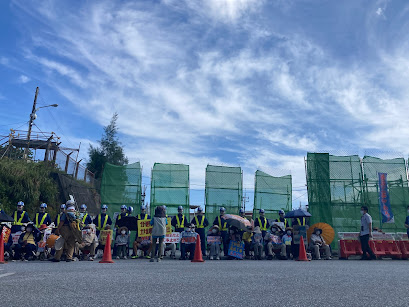OEJP Statement on Japanese Supreme Court’s Decision on Henoko Base Construction
September 5, 2023
OEJP Statement
on Japanese Supreme Court’s Decision to Dismiss Okinawa Governor’s Disapproval of Seafloor Reinforcement Work for Henoko Base Construction
On September 4, 2023, the Japanese supreme court delivered yet another blow to Okinawa Governor Denny Tamaki’s efforts and, thus, Okinawa people’s efforts to stop the Japanese and U.S. governments’ plan to construct a U.S. military base at Henoko-Oura Bay (Henoko base project) and to protect the area’s magnificent biodiversity. The Okinawa Environmental Justice Project condemns the court decision and declares that OEJP continues our fight to stop the Henoko base project and protect the environment of Henoko-Oura Bay.
 |
| Over 700 people gathered at a rally against the court decision on September 5 |
The Supreme Court rejected Governor Tamaki’s appeal and upheld the High Court decisions: Governor Tamaki’s disapproval of the Okinawa Defense Bureau’s application for change in design and construction (seafloor reinforcement work) for the Henoko base project was illegal; the directives the Ministry of Land, Infrastructure, Transportation and Tourism issued, requesting the Governor to approve the Bureau’s application, was legal; thus, Governor Tamaki must approve the application. The Supreme Court did not even allow him to present his arguments.
The Supreme Court decision prudently sustains the Japanese government’s pipedream that the extremely soft seafloor (with N-values being 0) found at the Oura Bay side of the construction site could be reinforced by methods proposed by the Defense Bureau without impacting the environment including the endangered Okinawa dugong. What this decision does in reality is help continue the unnecessary destruction of Henoko-Oura Bay while prolonging indefinitely the closure and removal of the Futenma Air Station in Ginowan City, for which the Henoko base is considered the replacement.
We emphasize that only the Japanese government, and now the court, claim that seafloor reinforcement work is feasible without impacting the Okinawa dugong and the environment. The U.S. government, whose military would use the base (if ever completed), has not shown any scientific assessment to support the Japanese government’s claims. All the evaluations publicly available from the U.S. government and U.S. think tanks cast doubt on the prospect of the Henoko base project being completed and point out technical and environmental difficulties associated with the project. Indeed, how does driving 71,000 piles of various types and sizes into the seafloor for reinforcement, with 16,000 of them being 1.6 to 2m (5.2 to 6.5 feet) in diameter, as deep as 90 meters (300 feet) below the water surface, not cause a disaster for the area’s 5,300 species including some 260 endangered species? The Japanese court decisions are an insult to these U.S. institutions and, ultimately, to the relationship between the U.S. and Japan.
The Okinawa Environmental Justice Project is determined to continue our fight to stop the Henoko base project and protect the environment of Henoko-Oura Bay. We invite and collaborate with international organizations and institutions with scientific knowledge, practice, and integrity to protect this irreplaceable, precious biodiversity for the world.
Contact
Hideki Yoshikawa
Director
Okinawa Environmental Justice Project
yhidekiy@gmail.com


